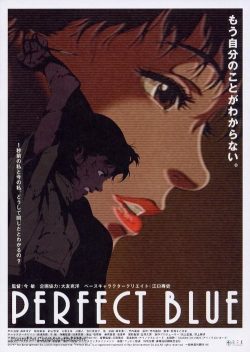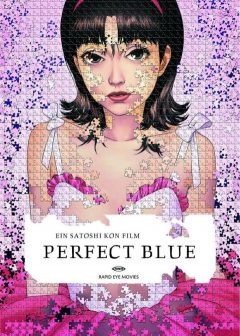 For a lot of fans growing up during the VHS anime era of the mid-to-late 90’s, getting a hold of a copy of your favorite show was a frustrating experience. You either had to buy wall-length VHS runs, borrow from your friends or movie store, or, god help you, tape them off the TV whenever the SyFy channel or Cartoon Networks Toonami was on, much like the early days of cassette trading. If you were real lucky, your local theater might have a one night showing of a movie, mostly ranging from Studio Ghibli hits to Ghost in the Shell or Akira. It was during this tumultuous era in animated entertainment that the notorious cult hit Perfect Blue began to make the rounds.
For a lot of fans growing up during the VHS anime era of the mid-to-late 90’s, getting a hold of a copy of your favorite show was a frustrating experience. You either had to buy wall-length VHS runs, borrow from your friends or movie store, or, god help you, tape them off the TV whenever the SyFy channel or Cartoon Networks Toonami was on, much like the early days of cassette trading. If you were real lucky, your local theater might have a one night showing of a movie, mostly ranging from Studio Ghibli hits to Ghost in the Shell or Akira. It was during this tumultuous era in animated entertainment that the notorious cult hit Perfect Blue began to make the rounds.
Released in 1997 by the late Satoshi Kon, Perfect Blue was what Texas Chainsaw Massacre was to horror fans; deemed to be one of the most intense and violent works at the time (and some argue, still now), it basically came out of nowhere. The story focused on popstar-turned-actress Mima Kirigoe who decides to re-invent herself into a more mature idol, which includes performing some pretty sketchy scenes in her first acting work. Unfortunately, not everyone is happy to see her change, highlighted by an online stalker named “Me-Mania” who quickly begins to terrorize her life, leading her to a schizophrenic breakdown of EPIC proportions. Throw in some dead bodies, a smidge-too-long rape scene, and a whole lot of crazy, and you got yourself Perfect Blue. That’s not say the movie doesn’t have any merits. The work is beautifully animated and offers a scathing critique of pop-culture consumption as well the depths and depravity of the human psyche and the immense demands of success. The movie launched Satoshi Kon’s career and received high praise from critics and fans alike.
Perfect Blue, which came out at a time when parents were letting their kids rent adult anime because “it’s just cartoons,” was a turning point in both animation and nightmares, but what most fans didn’t know was that it was first a book. Released in 1992 as Perfect Blue: Complete Metamorphosis and re-released in English a mere month ago, I have just recently had the pleasure of reading the book that inspired the cult film, and strangely enough, it’s different from the movie adaption. Don’t get me wrong, it’s still pretty grotesque, but it’s a whole different kind of grotesque. Penned by self-proclaimed ‘pop-idol superfan’ Yoshikazu Takeuchi, the novel deals with the same heavy subjects of idol-obsession and mental illness, but the only real thing it shares with the movie is some of the characters.
In the book, Mima is a solo pop-idol singer who decides to reinvent her image by releasing a risqué photobook in succession with her newest hit. When news hits the ears of her fans, one obsessive fan, who had already been harassing her with phone calls, decides that he needs to ‘save her’ from making the photobook. Despite persistent phone calls and hand delivered letters warning her of the consequences, she proceeds to release the book anyway and throws the fan into a suicidal spiral who decides that the best course of action to kill them both. On top of the fan, Mina also has to deal with a rival popstar who determined to smear her name, culminating in a test of Mina’s mental strength as well as her perseverance in the face of open hostility.
As stated, the movie and book share similar themes, but the overall story is markedly different. In the book, Mina retains her sanity throughout the ordeal while movie Mina loses her shit pretty damn quick, which further pushes the movie’s plot away from human threat to one inside Mina’s mind. In the book, the threat is very real, unlike the bizarre and unstable nightmare of the movie’s world. Also, in the movie, the stalker is kept under wraps until the final ending, while in the book the stalker (an original and different character only mentioned in the movie as a ‘fever dream’) is not only openly revealed in the first few pages but is an integral part of the story. The book frequently bounces back-and-forth between Mina and her super-fan, giving the reader a deeper look at the untethered workings of his madness. Finally, there aren’t nearly as many people being bumped off in the book, but the ones that do get killed get really fucked up in a psychosexual orgy of violence and depravity. I definitely found myself making faces at some of the more…descriptive parts. Despite what the “older teen” tag on the back of the book, this is not a Y book, don’t give it to your teens.
 Of course, the real question is: is it good? Well, sort of. The first thing the reader notices when opening the book is the layout of the print. It’s huge! It’s already a relatively short book, coming in at only 208 pages, but with the Harry Potter-size text, the work can easily be read in a few hours. Because it’s such a quick read, the writer crams as much action and insanity as he can which doesn’t leave a lot in terms of character development. Granted, that’s fine when it comes to the stalker, especially since the book mostly focuses on his thoughts about Mina and how he wants to kill her, which makes him even creepier as he was most likely just born a nutjob, but it leaves a lot of questions about the other characters. Why is Mina so calm in the face of increasing death threats? Why is her popstar rival, Eri Ochiai, so determined to bring specifically her down? Why is her assistant Rumi, a failed singer herself, so loyal to Mina that she’s willing to die for her? The books simply plows through with a “that’s the way it is” attitude, choosing to focus on the action side of the work.
Of course, the real question is: is it good? Well, sort of. The first thing the reader notices when opening the book is the layout of the print. It’s huge! It’s already a relatively short book, coming in at only 208 pages, but with the Harry Potter-size text, the work can easily be read in a few hours. Because it’s such a quick read, the writer crams as much action and insanity as he can which doesn’t leave a lot in terms of character development. Granted, that’s fine when it comes to the stalker, especially since the book mostly focuses on his thoughts about Mina and how he wants to kill her, which makes him even creepier as he was most likely just born a nutjob, but it leaves a lot of questions about the other characters. Why is Mina so calm in the face of increasing death threats? Why is her popstar rival, Eri Ochiai, so determined to bring specifically her down? Why is her assistant Rumi, a failed singer herself, so loyal to Mina that she’s willing to die for her? The books simply plows through with a “that’s the way it is” attitude, choosing to focus on the action side of the work.
But the book, much like the movie, does provide an all-access to look at the behind the scenes of pop stardom. The schedules, the compromises, the frequently uncomfortable situations that idols find themselves in. There are millions of nuances that need to go through an idol’s mind; if not handled properly, each one can be easily used as a way to end their career. The work really shows how tough it is to be a Japanese idol and how obsessive some fans can be, something that is an actual problem for many celebrities, especially in the male-fan dominated world of J-Pop. Though most won’t go to the extreme as the killer in the book, it does get pretty dicey sometimes, and death threats aren’t that uncommon.
Another interesting, if not perverse, angle of the work is the lengths the writer goes in describing the murder and torture scenes. If you’re into that stuff (I’m not judging), it gets pretty damn intense and very original. This is like gore-porn the book; it goes hard for the shock angle and never really lets up. Hell, the first few pages focuses on the stalker kidnapping a little girl, and though we never learn what he does with her, we get some clues later on in the book. This sets up a steady increase in violence and obsession, building toward an end scene of cat-and-mouse goregasm until the book just kind of ends. I guess what I’m saying is, don’t expect much, but your perverted ass will be entertained.
If I have sold you on this strange tale of obsession and murder-most-foul, the book is available pretty much everywhere. I got my copy off Amazon, but I’m sure you can find it in a book or comic book store as well. The movie Perfect Blue has been readily available for years and comes in different DVD formats, though it does seem overdue for another release, as the DVD’s prices range from double to triple digits depending on what copy you want. Just whatever you do, be prepared for a crazy ride, and don’t watch it with your kids.
